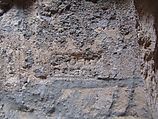Oxen
Manufacturer Grueby Pottery
Designer Addison B. Le Boutellier
William H. Grueby (1867–1925), perhaps more than any other individual ceramist, directed the course of American pottery toward matte glazes at the turn of the century. The glazes that he produced at his Boston pottery, founded in 1897, were described as a “very dull mat,” others as having a “crackled effect running all through it under the glaze,” or, alternatively, “mottled wave lines running around the surface.” Gray, dappled green, pale green, warm brown, and a mottled silvery yellow were some of the colors enumerated in the period press, but a dark green soon became the predominant color associated with the pottery. Grueby partnered with the architect George Prentice Kendrick, who provided the designs for most of the vases made by the pottery.
Concurrent with its vase production, the Grueby firm produced tiles. Indeed, this was probably the major portion of their commercial business. Much of the output was devoted to plain glazed tiles in stock patterns that architects incorporated into their commissions. After 1900 the company devoted its attention to producing tiles with Arts and Crafts-style designs that complemented the firm’s richly colored matte glazes. For architectural commissions, such as New York City’s subway stations, the architects Kendrick and Addison B. LeBoutellier assumed a major role in designing the tiles.
Among the most notable of Grueby’s tiles are the pictorial friezes that were frequently shown in American Arts and Crafts exhibitions. This one depicts a farm wagon driven by a team of four oxen and accompanied by the farmer. Although smaller, it is nearly identical to a Grueby tile frieze that was created around 1902 for the mantel in the nursery at Dreamwold Estate, the impressive farm house of Thomas W. Lawson in Scituate, Massachusetts, where all the rooms had Grueby tiles. The subject undoubtedly reflected the owner’s particular tastes; Lawson had a special herd of Jersey cattle. The frieze has a charming, rustic simplicity, which may explain why Grueby put the design into production and why other clients bought it on purely artistic grounds.
Due to rights restrictions, this image cannot be enlarged, viewed at full screen, or downloaded.
This artwork is meant to be viewed from right to left. Scroll left to view more.






